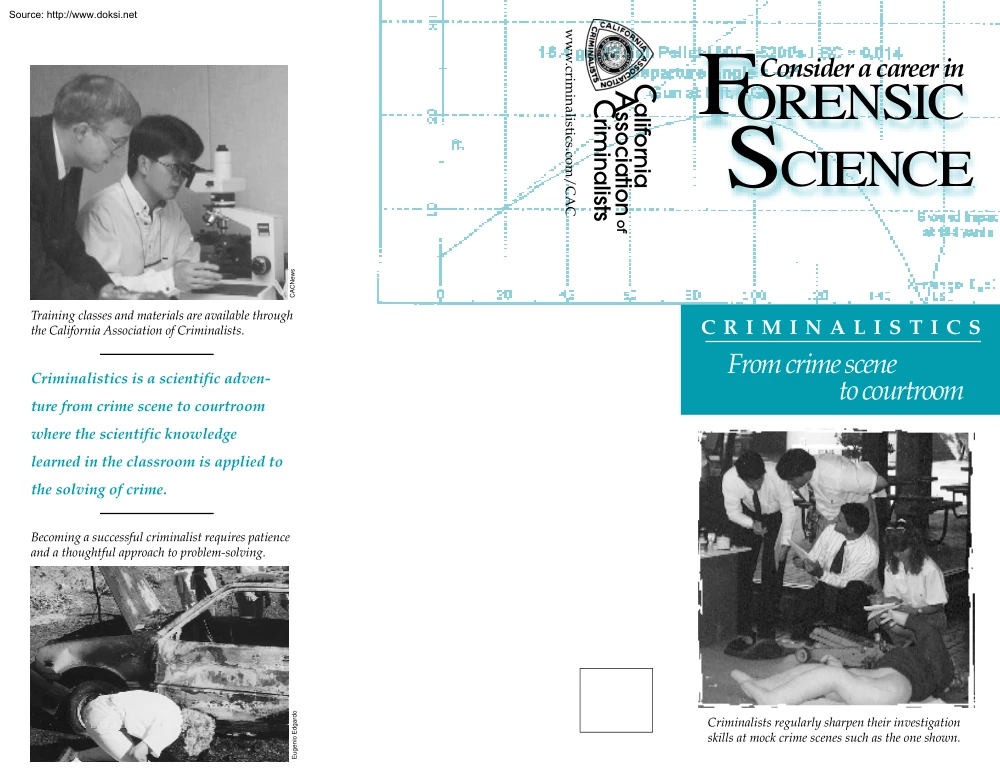A doksi online olvasásához kérlek jelentkezz be!

A doksi online olvasásához kérlek jelentkezz be!
Nincs még értékelés. Legyél Te az első!
Tartalmi kivonat
Source: http://www.doksinet CACNews California Association of Criminalists www.criminalisticscom/CAC FORENSIC SCIENCE Consider a career in Training classes and materials are available through the California Association of Criminalists. CRIMINALISTICS From crime scene to courtroom Criminalistics is a scientific adventure from crime scene to courtroom where the scientific knowledge learned in the classroom is applied to the solving of crime. Eugenio Edgardo Becoming a successful criminalist requires patience and a thoughtful approach to problem-solving. Criminalists regularly sharpen their investigation skills at mock crime scenes such as the one shown. Source: http://www.doksinet CRIMINALISTICSthe challenge of forensic science FIREARMS AND TOOLMARKS Criminalists provide information to investigators about the caliber and type of firearm used in a crime. Scratches, or striation marks, are left on bullets by the barrel of a pistol or rifle. Once a firearm is recovered,
these marks can individualize a bullet to a unique firearm to the exclusion of all other firearms. Similarly, tools used in crimes can leave striation and other marks on surfaces. These marks can be compared to the tool believed to have made them. If the comparison is a positive match, a tool may be individualized as having made the mark to the exclusion of all other tools. A computer database of marks on cartridge cases and bullets has been developed to link a particular firearm to serial crimes CRIMINALISTICS is one of many divisions in the field of forensic science. Forensic science includes forensic pathology, odontology, entomology, engineering, criminology, and other disciplines. All of these are specialized sections in forensic science. Criminalists use techniques learned in chemistry, molecular biology, geology, and other scientific disciplines to investigate and solve crimes. Criminalistics should not be confused with the field of criminology. Criminologists are sociologists,
psychologists, and others who TRACE EVIDENCE study the causes and effects of crime on society. Trace evidence, frequently overlooked because of its microscopic size, applies microanalysis to fibers, hair, soil, paint, glass, pollen, explosives, gunshot residue, food, plastic bags, and virtually anything involved in a crime. No training exists that will prepare the trace evidence analyst for every kind of case that will cross their workbench, as each case is fascinatingly unique. By having a thorough knowledge of the advantages and disadvantages of microscopic, spectroscopic, and chromatographic methods, the criminalist can meet the analytical challenge of each case. CACNews For the criminalist, crime scene investigation involves the recognition, documentation, collection, preservation, and interpretation of physical evidence which may be as A criminalist prepares an experiment in bloodspatter pattern analysis. big as a truck or as small as a diatom or pollen grain. Recognition
of items out of place, articles improperly located or items added to the crime scene are an important part of Criminalists are scientists who evaluate, crime scene processing. The criminalist collects, preserves, compare, analyze and interpret physical and makes interpretations about the evidence and their DNA AND SEROLOGY relation to the series of events resulting at the crime scene. evidence taken from crime scenes, and from The criminalist brings evidence back to the labora- suspects, victims, or others possibly related tory where examinations will be conducted. Interpretations to a crime. crime scene by associating particular items of evidence to In the mid 1980s, deoxyribonucleic acid (DNA) techniques began to be applied to forensic cases. Any tissue from the body carrying the genetic code of DNA may be used to compare to a standard. This allows blood to be associated uniquely to a single individual. Databases of DNA profiles are being compiled to aid in identifying
criminals and have already been used to solve cases many years old, where samples were properly preserved and reanalyzed. In some cases innocent persons have even been released from prison based on the reanalysis. are made about the relevance of a particular item from the specific sources and reconstructing the crime scene. This means not only associating a suspect with a scene but also Criminalists use complex, state-of-the-art scientific equipment to compare evidence recovered at crime scenes. the telling of a story about what transpired before, during and after the crime. DRUGS, ALCOHOL AND TOXICOLOGY The criminalist must draw on a wide spectrum of scientific knowledge including chemistry, biology, genetics, molecular biology, physics, statistics and a working knowledge of civil and criminal law. Applying this knowledge, criminalist will associate and identify evidence, interpret the results, reconstruct the crime scene, and write a report CACNews in courts of law, teaching
the judge and jury about the conclusions reached in the laboratory. Raymond Davis summarizing the findings. Finally, the criminalist testifies The criminalist uses a battery of analytical tools and their knowledge of chemistry to identify controlled substances in powders, pills and liquids and body fluids. A criminalist may be called to a clandestine laboratory by investigators, where illegal drugs are produced. Criminalists are frequently responsible for maintaining breath alcohol analysis instruments and training of the laboratory technicians and police officers who run the tests on those suspected of driving under the influence. Sometimes no controlled substance is present and sometimes more than one kind of drug can be detected in a sample
these marks can individualize a bullet to a unique firearm to the exclusion of all other firearms. Similarly, tools used in crimes can leave striation and other marks on surfaces. These marks can be compared to the tool believed to have made them. If the comparison is a positive match, a tool may be individualized as having made the mark to the exclusion of all other tools. A computer database of marks on cartridge cases and bullets has been developed to link a particular firearm to serial crimes CRIMINALISTICS is one of many divisions in the field of forensic science. Forensic science includes forensic pathology, odontology, entomology, engineering, criminology, and other disciplines. All of these are specialized sections in forensic science. Criminalists use techniques learned in chemistry, molecular biology, geology, and other scientific disciplines to investigate and solve crimes. Criminalistics should not be confused with the field of criminology. Criminologists are sociologists,
psychologists, and others who TRACE EVIDENCE study the causes and effects of crime on society. Trace evidence, frequently overlooked because of its microscopic size, applies microanalysis to fibers, hair, soil, paint, glass, pollen, explosives, gunshot residue, food, plastic bags, and virtually anything involved in a crime. No training exists that will prepare the trace evidence analyst for every kind of case that will cross their workbench, as each case is fascinatingly unique. By having a thorough knowledge of the advantages and disadvantages of microscopic, spectroscopic, and chromatographic methods, the criminalist can meet the analytical challenge of each case. CACNews For the criminalist, crime scene investigation involves the recognition, documentation, collection, preservation, and interpretation of physical evidence which may be as A criminalist prepares an experiment in bloodspatter pattern analysis. big as a truck or as small as a diatom or pollen grain. Recognition
of items out of place, articles improperly located or items added to the crime scene are an important part of Criminalists are scientists who evaluate, crime scene processing. The criminalist collects, preserves, compare, analyze and interpret physical and makes interpretations about the evidence and their DNA AND SEROLOGY relation to the series of events resulting at the crime scene. evidence taken from crime scenes, and from The criminalist brings evidence back to the labora- suspects, victims, or others possibly related tory where examinations will be conducted. Interpretations to a crime. crime scene by associating particular items of evidence to In the mid 1980s, deoxyribonucleic acid (DNA) techniques began to be applied to forensic cases. Any tissue from the body carrying the genetic code of DNA may be used to compare to a standard. This allows blood to be associated uniquely to a single individual. Databases of DNA profiles are being compiled to aid in identifying
criminals and have already been used to solve cases many years old, where samples were properly preserved and reanalyzed. In some cases innocent persons have even been released from prison based on the reanalysis. are made about the relevance of a particular item from the specific sources and reconstructing the crime scene. This means not only associating a suspect with a scene but also Criminalists use complex, state-of-the-art scientific equipment to compare evidence recovered at crime scenes. the telling of a story about what transpired before, during and after the crime. DRUGS, ALCOHOL AND TOXICOLOGY The criminalist must draw on a wide spectrum of scientific knowledge including chemistry, biology, genetics, molecular biology, physics, statistics and a working knowledge of civil and criminal law. Applying this knowledge, criminalist will associate and identify evidence, interpret the results, reconstruct the crime scene, and write a report CACNews in courts of law, teaching
the judge and jury about the conclusions reached in the laboratory. Raymond Davis summarizing the findings. Finally, the criminalist testifies The criminalist uses a battery of analytical tools and their knowledge of chemistry to identify controlled substances in powders, pills and liquids and body fluids. A criminalist may be called to a clandestine laboratory by investigators, where illegal drugs are produced. Criminalists are frequently responsible for maintaining breath alcohol analysis instruments and training of the laboratory technicians and police officers who run the tests on those suspected of driving under the influence. Sometimes no controlled substance is present and sometimes more than one kind of drug can be detected in a sample




